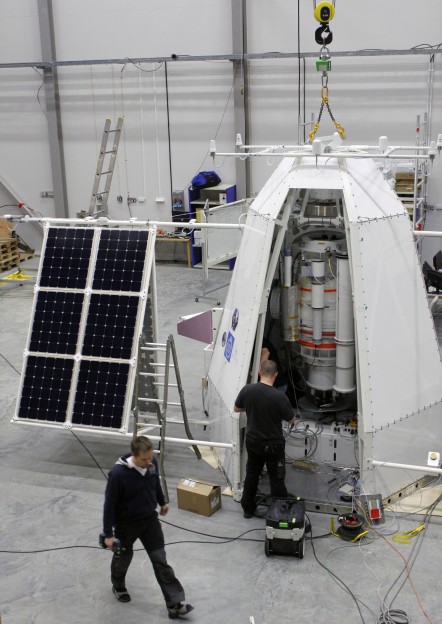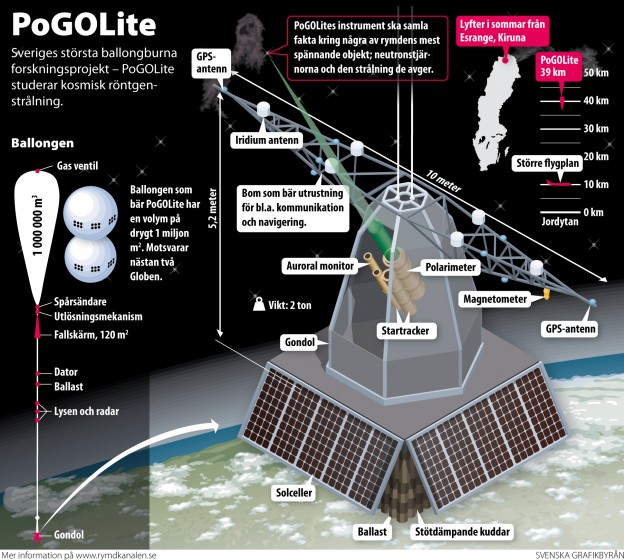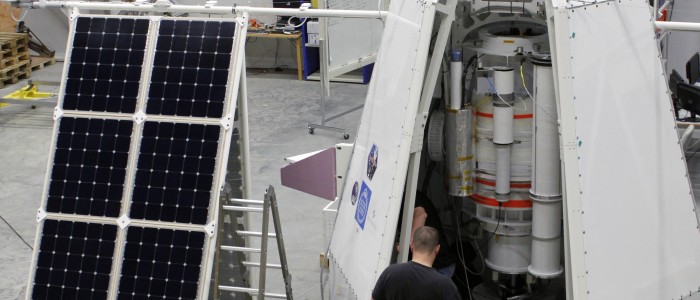
The last preparations of the scientific payloads. Credit: KTH (The Royal Institute of Technology
Last summer the Swedish PoGOLite mission drifted in the stable easterly wind around the North Pole from Esrange in Sweden over Greenland to the northern part of Canada and Russia for two weeks. The ultimate goal was to land the balloon in Sweden, but with chances of more southerly wind and drift towards the Arctic oceans, the team landed the balloon in the Northwest Russia after 14 days. The balloon lifted a scientific payload at 1900 kg to a height of 39 km, high above most of the atmospheric disturbance and pollution.
The PoGoLite project is a collaborative project between Swedish, Russian, Japanese and US scientific teams. Mark Pearce from KTH (The Royal Institute of Technology) is a spokesperson for the international PoGOLite Collaboration, and is head of the Swedish Consortium.
Nordicspace interviewed Mark Pearce about the results in December 2013, and this is his written reply:
-We are still waiting to recover the hard disks (solid-state disks, actually) which contain the scientific data. We launched later in the day than expected which resulted in our observations being conducted mostly while we had contact with the gondola over slow Iridium data links (rather than the fast Esrange E-Link system). This is because our scientific target (see below) is only visible at certain times of the day. Due to Iridium, we were only able to download data summary files and very little raw data. The gondola landed in Russia after an almost circumpolar flight from Esrange. Customs formalities have delayed the return of the gondola to Sweden. A recovery team is now in Russia and so we hope to have the disks back before the end of the year.
How will you apply the data?
-Our aim is to measure X-rays from ‘the Crab’ – a so-called pulsar which is 6500 light years from Earth. In particular, we study the polarisation of the X-rays, which is a new type of measurement. This will allow us to better understand how the X-rays are generated.
Are there plans for a follow-up mission?
– We hope so! This was the maiden flight of our payload – “the PoGOLite pathfinder”. As well as hoping to conduct scientific studies, an important aim was to test and evaluation technical solutions and design choices. We plan to improve the payload and conduct further balloon flights – especially long duration circumpolar flight which give long observation times. We have also proposed an extension of the PoGOLite programme as part of Swedish Space Boards’s small national satellite programme. The selection process is on-going.
Polar vortex is a stable arctic wind from east to west during the summer time. The wind is continually and is used of several missions before, but PoGOLite was planned to be the first mission to fly the whole circumference and land in Scandinavia around two to three weeks later. The mission mainly followed the Polar Circle at latitude around 68 – 70 degree north, but with landing the latitude was 71degree north and steady more northerly.
PoGOLite

The mission. (Text in Swedish.) Credit: KTH (The Royal Institute of Technology)
The light-weight Polarized Gamma-ray Observer (PoGOLite) experiment is designed to measure the polarization of soft gamma rays in the 25 keV – 80 keV energy range.
The main aim with the mission was to investigate the gamma rays from the universe at a specific energy range.
To investigate space phenomena with instrument at platforms outside the atmosphere is the ultimate solution for most of the space research community. Satellites are ideal, but a very expensive solution. However, balloons can also loft instruments over the thickest part of atmosphere and over most of the air pollution, to a much lower cost. The low cost, minimum technical constraints and rapid project execution mean that balloons can be exceptional space vehicles. However
Swedish Space Corporation (SSC) has build the outer structure of the payload with solar panels and is also in charge of the power system, data communication and the security system. SSC will be in charge of the launch facilities at EsrangeSpaceCenter.
Read more at: www.particle.kth.se/pogolite/


